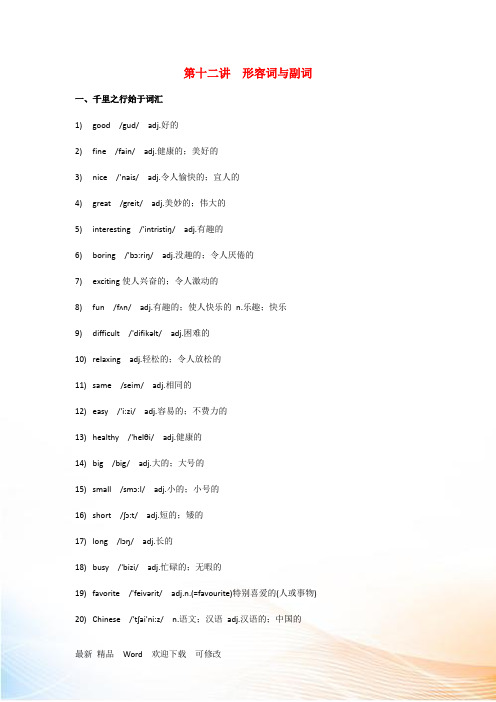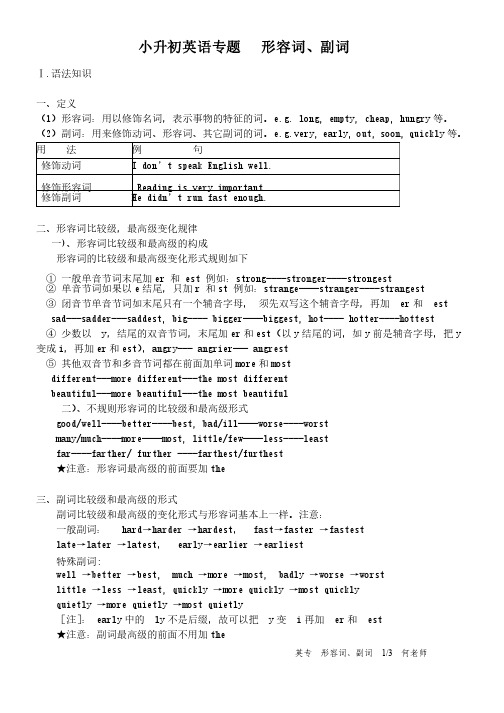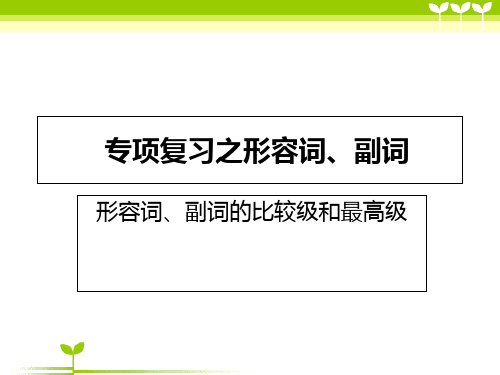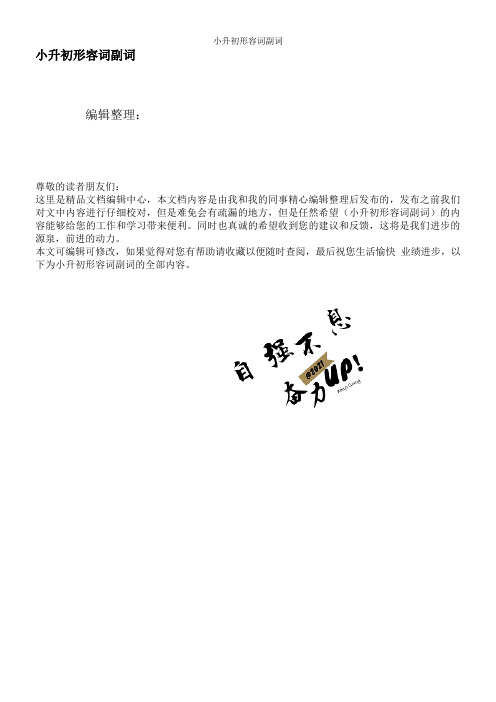小升初形容词和副词
小升初形容词、副词及其比较等级-课件

• 三、形容词、副词比较级的用法 表示两者间的比较用比较级。其常 见句式有:
• 1.“A + be +形容词比较级 + than + B” 意思为“A比B更……”。
• 如:This tree is taller than that one. 这棵树比那棵树高。
• 注 ① 在含有连词than的比较级中,前后的比较对象必须是同一范畴, 即同类事物之间的比较。
专项复习之形容词、副词
形容词、副词的比较级和最高级
• 一般来说,中文意思是“……的”的词是形容词,而中文 意思是“……地”的词是副词。
• 一、形容词概念
• 形容是用来修饰物体的形状,大小,长度,属性,特点等, 位于名词的前面。
• 如:1.He is a hard-working student.(努力的→特点)
• 注:表示“越来越……”时,若比较级是“原级 + er”构成的,则常用 “比较级 + and + 比较级”形式;若比较级是“more + 原级”构成 的,需用“more and more + 原级形式”。 如:Our school is becoming more and more beautiful. 我们的学校变得越来越美丽。
• ②在比较级前面使用much,表示程度程度“强得多”。 如:A watermelon is much bigger than an apple.
• ③ very, quite一般只能修饰原级,不能修饰比较级。
• 2.“become + 形容词比较级 + and + 形容词比较级”是“变得越 来越……”的意思,and连接同一个形容词的比较级。
• 3.以不发音e结尾的单音节词,比较在原级后加-r,最高级在原级后 加-st; 如:large→larger→largest nice→nicer→nicest
小升初英语专题讲解十二形容词与副词

第十二讲形容词与副词一、千里之行始于词汇1)good/gud/adj.好的2)fine/fain/adj.健康的;美好的3)nice/'nais/adj.令人愉快的;宜人的4)great/greit/adj.美妙的;伟大的5)interesting/'intristiŋ/adj.有趣的6)boring/'bɔ:riŋ/adj.没趣的;令人厌倦的7)exciting使人兴奋的;令人激动的8)fun/fʌn/adj.有趣的;使人快乐的n.乐趣;快乐9)difficult/'difikəlt/adj.困难的10)relaxing adj.轻松的;令人放松的11)same/seim/adj.相同的12)easy/'i:zi/adj.容易的;不费力的13)healthy/'helθi/adj.健康的14)big/big/adj.大的;大号的15)small/smɔ:l/adj.小的;小号的16)short/ʃɔ:t/adj.短的;矮的17)long/lɔŋ/adj.长的18)busy/'bizi/adj.忙碌的;无暇的19)favorite/'feivərit/adj.n.(=favourite)特别喜爱的(人或事物)20)Chinese/'tʃai'ni:z/n.语文;汉语adj.汉语的;中国的21)free/fri:/adj.空闲的;免费的22)cool/ku:l/adj.妙极的;酷的23)useful/'ju:zful/adj.有用的;有益的24)funny adj奇怪的;滑稽好笑的25)clean 干净的26)far 远的27)new 新的28)afraid 害怕的;惧怕的29)sorry 抱歉的;难过的;惋惜的30)important 重要的31)quiet 安静的32)cute adj可爱的;机灵的33)lazy 懒散的;懒惰的34)smart adj 聪明的35)beautiful adj 美丽的;美好的36)scary adj吓人的;恐怖的37)shy adj 羞怯的;腼腆的38)young 幼小的,年轻的39)delicious .adj 可口的.美味的40)windy 多风的41)cloudy多云的42)sunny晴朗的43)bad坏的;糟的44)dry干燥的45)cold寒冷的;冷的46)hot热的47)warm温暖的48)hard努力地;困难的49)snowy下雪的50)rainy阴雨的;多雨的51)dirty 脏的52)noisy 吵闹的53)terrible 非常讨厌的;可怕的54)strict 严格的;严厉的55)curly卷曲的56)straight直的57)tall高的58)medium中等的59)thin瘦的60)heavy重的61)handsome英俊的62)special特色菜;特价品;特别的;特殊的63)large大号的;大的64)different不同的65)lucky幸运的66)popular受欢迎的;普遍的67)dark黑暗的;昏暗的68)natural自然的69)scared惊慌的二、重点短语集锦1)be strict with sb2)be strict in sth3)get popular受欢迎;流行4)be interested in5)be good at6)be good with7)be good for8)do well in9)keep healthy10)be busy with sth11)be busy doing sth12)be free13)be afraid of14)be afraid to do sth15)be sorry for16)be the same as17)be different from18)be quite19)jump high20)work hard三、形容词与副词1、形容词1) 修饰名词,描述其性质、品质、特征等的词。
小升初英语专题-形容词、副词

Ⅰ.语法知识Ⅰ.语法知识一、定义一、定义(1)形容词:用以修饰名词,表示事物的特征的词。
)形容词:用以修饰名词,表示事物的特征的词。
e.g. long, empty, cheap, hungry e.g. long, empty, cheap, hungry 等。
等。
(2)副词:用来修饰动词、形容词、其它副词的词。
)副词:用来修饰动词、形容词、其它副词的词。
e.g.very, e.g.very, early, out, soon, quickly 等。
用 法法例 句句 修饰动词修饰动词I don’t speak English well.I don’t speak English well. 修饰形容词修饰形容词Reading is very important. 修饰副词修饰副词 He didn’t run fast eno He didn’t run fast enough. ugh.二、形容词比较级,最高级变化规律二、形容词比较级,最高级变化规律一一)、形容词比较级和最高级的构成、形容词比较级和最高级的构成形容词的比较级和最高级变化形式规则如下形容词的比较级和最高级变化形式规则如下形容词的比较级和最高级变化形式规则如下① 一般单音节词末尾加① 一般单音节词末尾加er er 和和 est est 例如:例如:例如:strong----stronger----strongest strong----stronger----strongest② 单音节词如果以② 单音节词如果以e 结尾,只加r r 和和st st 例如:例如:例如:strange----stranger----strangest strange----stranger----strangest ③ 闭音节单音节词如末尾只有一个辅音字母,③ 闭音节单音节词如末尾只有一个辅音字母,③ 闭音节单音节词如末尾只有一个辅音字母, 须先双写这个辅音字母,再加 er est 和 est sad---sadder---saddest, big---- bigger----biggest, hot---- hotter----hottest ④ 少数以④ 少数以 y,结尾的双音节词,末尾加er 和est est(以(以y 结尾的词,如y 前是辅音字母,把y 变成i ,再加er 和est est)),angry--- angrier--- angrest ⑤ 其他双音节和多音节词都在前面加单词⑤ 其他双音节和多音节词都在前面加单词more 和mostdifferent---more different---the most differentbeautiful---more beautiful---the most beautiful二)二)、不规则形容词的比较级和最高级形式、不规则形容词的比较级和最高级形式good/well----better----best, bad/ill----worse----worstmany/much----more----most, little/few----less----leastfar----farther/ further ----farthest/furthest★注意:形容词最高级的前面要加the三、副词比较级和最高级的形式三、副词比较级和最高级的形式副词比较级和最高级的变化形式与形容词基本上一样。
小升初英语复习:形容词、副词

(1) “A + be +形容词比较级+ than + B”意思为“A比B更……”。
如:My pen is cheaper thanyours . 我的笔比你的便宜。
Tom runs faster thanyou. 汤姆比你要跑得快。
(2) 进行选择性比较时,可用“which/ who+be+形容词比较级,A or B ?”表示“A和B中,哪一个/ 谁更……..?”。
如:Who is taller (tall), Lucy or Lily? 露西和丽莉谁更高?(3) “比较级 + and + 比较级”或“more and more +原级”表示“越来越……”如:It becomes warmer and warmer when spring comes.春天来了,天气变得越来越暖和了。
(4) “the +比较级……, the+比较级......”,表示“越……越……”如:The more money you make, the more you spend.钱你赚得越多,花得越多。
温馨提示:a bit, a little, much, a lot, still, even 可修饰形容词或者副词的比较级。
Peter is much taller(tall) than Daming. 彼得比大明高得多。
(三) 最高级用法形容词、副词的最高级形式主要用来表示三者或三者以上人或事物的比较,表示“最……”的意思。
句子中有表示范围的词或短语。
如:of the three, in our class等。
结构:(1) Who + be + the + 形容词最高级,A, B or C? 表示“ABC中谁最…..?”Who is the most beautiful (beautiful)girl, Lily, Lucy or Lingling?丽莉、露西和玲玲谁是最漂亮的?(2) Which + be + the + 形容词最高级,A, B or C? 表示“ABC中哪一个最…..?”Which bag is the heaviest(heavy), the yellow one, the red one or the black one?哪个包包最重,黄色的,红色的还是黑色的?(3) A + 谓语 + the + 形容词/副词最高级 + 表示范围的短语(of/ in…) .表示“A在哪一范围内是最…..?”如:He is the tallest (tall) in our class. 他在我们班里是最高的。
小升初重要知识点整理常见形容词与副词用法总结

小升初重要知识点整理常见形容词与副词用法总结在小升初备考过程中,掌握好形容词与副词的用法是非常重要的。
形容词与副词的正确运用,不仅能够提升文章的表达能力,还能够增加语句的准确性和语感。
下面是小升初常见的形容词与副词用法总结。
一、常见形容词的用法:1. 形容词修饰名词:例句:这只小猫很可爱。
2. 形容词修饰不定代词或疑问代词:例句:几个小孩在笑。
3. 形容词修饰主语时,可以使用主动形式表示主语的特征:例句:他们主动帮助了别人。
4. 形容词修饰物体时,可以使用被动形式表示物体的状态:例句:这个箱子被打开了。
5. 形容词修饰名词时,可以使用比较级和最高级:例句:这本书比那本书更有趣。
6. 形容词修饰名词时,可以使用形容词的反义词:例句:这位老师很和蔼,对学生很严厉。
二、常见副词的用法:1. 副词修饰动词:例句:他慢慢地走了过来。
2. 副词修饰形容词:例句:他非常高兴。
3. 副词修饰副词:例句:她非常非常聪明。
4. 副词修饰整个句子,表示说话者的观点或态度:例句:幸运地,我们考试取得了好成绩。
5. 副词修饰动词时,可以使用副词的比较级和最高级:例句:他跑得比谁都快。
6. 副词修饰形容词时,可以使用副词的反义词:例句:这件事情非常不错,值得肯定。
以上是小升初备考中常见的形容词与副词用法总结。
掌握好这些规则,在写作和作文中就能够运用自如。
通过大量的练习,良好的语感和准确的表达能力也会逐渐形成。
希望能对同学们的备考有所帮助!。
小升初英语总复习 第二章 词类 第五节 形容词和副词课件(通用)

举一反三
1. 写出下列单词的比较级和最高级。 (1) late→ later → latest (2) thin→ thinner → thinnest (3) easy→ easier → easiest (4) useful→ more useful → the most useful 2. 根据画线的形容词判断下列句子的说法是否正 确,正确的在括号里打“√”,错误的打“×”。
A. delicious B. bad
C. badly
2. 按要求改写句子,使句意不变。 (1) I'm 135 cm tall. My sister is 135 cm tall, too. (用同 级表达)
I'm as tall as my sister. /My sister is as tall as me. (2) Tom is 13 years old. Jim is 14 years old. (用比较级
此句空格上应填well的比较级better来修饰动词sing。
第三句中有表范围的介词in our school,此句修饰sing
的副词应是well的最高级best。
答案:well;better;best
【例5】请将下面的两句话合并成一句。 I'm 11 years old. My sister is 8 years old.
【注】(1)部分名词加ly变成副词。如: part—partly (部分地)
(2)并不是所有以ly结尾的词都是副词,有的名词加ly 是形容词。
如:friend—friendly(友好的), mother—motherly(母亲般的), father—fatherly(父亲般的), sister—sisterly(姐妹般的), brother—brotherly(兄弟般的), love—lovely(可爱的),day—daily(每日的) (3)有些名词加y变成形容词。若名词以重读闭音节结 尾且词尾只有一个辅音字母,需双写该辅音字母再加y。 如:rain—rainy,snow—snowy,cloud—cloudy, wind—windy,fog—foggy,sun—sunny,salt—salty,luck— lucky,health—healthy
小升初形容词副词【精选】整理版

形容词和副词一.形容词1.修饰名词,描述其性质、品质、特征等的词。
一般“…的”的词都是形容词。
如:She is a beautiful girl. (漂亮的)2.在句中作定语、表语、宾语补足语。
如:I have an interesting book. (interesting有趣的,修饰book,在句中作定语)We are happy today. (happy快乐的,在句中作表语)Students should keep their classroom clean and tidy.(clean干净的,tidy整洁的,在句中都作宾语补足语)3.多个形容词同时修饰一个名词时的排列顺序限定词+外观类+形状+年龄+颜色+国籍+材料+名词(简记:县官行令色国才)如:a tall 17-year-old black American boy. 一个17岁的高个子黑皮肤美国男孩。
the big round red wooden table. 又大又圆的红色木质饭桌。
二.副词:1.通常修饰动词,表示动作的程度、方式等。
还可修饰形容词、副词,有时修饰整个句子,在句中作状语。
一般“…地”的词都是副词。
如:You must listen to the teacher carefully.(仔细地,认真地)2.副词的分类1) 时间副词: now, today等2)频度副词:always, usually, often, sometimes, seldom, never2) 地点副词:here, there, upstairs, downstairs等3) 方式副词:carefully, fast, well, politely等4) 程度副词: much, little, quite等5) 疑问副词: how, when, where, why等三.形容词转化成副词1.一般在形容词后加ly, 如:quick-quickly2.以辅音字母+y结尾的形容词,变y为i, 加ly, 如:happy-happily3.以ue 结尾的形容词,去e加ly, 如:true-truly注:有些词兼有形容词和副词的词性,如:fast, hard, high, late, far等,它们的词性只有通过具体语境来判断。
六年级下册英语课件-小升初6-形容词和副词专题讲解(共13张ppt)全国通用

• 一、写出下列形容词或副词的比较级
小升初专题六 形容词和副词
Elva
1
➢ 形容词adj. ➢副词adv. ➢形容词副词比较级最高级 ➢变化规则
2
一、形容词和副词的形式&区别
1.形容词和副词有三种形式: • 原级、比较级、最高级。 • 原级就是形容词和副词的原形,如long;比较级就是在原
形之后加上er,如longer;最高级就是在原形之后加上 est,如longest。 2.形容词与副词的区别 (有be用形,有形用be;有动用副, 有副用动) • ⑴在句子中形容词一般处于名词之前或be动词之后 • ⑵副词在句子中最常见的是处于实义动词之后
old____________ young____________ tall___________ long____________ short____________strong____________ big____________ small___________ fat_____________ thin______________ heavy__________ light___________ nice_____________ good_____________ beautiful______________________ low______________high_____________ slow___________ fast_____________ late______________ early_____________ far___ __________ well_________
小升初 形容词、副词专题

2.3 形容词的比较级变化规则
(1) 一般直接在词后+er e.g. quick-quicker/ fast-faster slow-slower tall-taller 单音节词如果以-e结尾,则直接加-r e.g. late-later
(2) 重读闭音节词如果末尾只有一个 辅音字母,须双写这个字母,再加-er e.g. big-bigger thin-thinner fat-fatter
(5) 不规则变化 e.g. good/well-better-best
(原级) (比较级) (最高级)
bad/ill-worse-worst many/much-more-most
far-farther/further-farthest/furthest old-older/elder-oldest/eldest
4) Whose bag is ____ ( heavy ), yours or mine? 5) Does Jim run as ___(slow ) as David? Yes, but Mike runs_____ ( slow ) than them.
6) You have seven books, but I have _______ ( many ) than you. I have ten. 7) I jump ______ ( far ) than some of the boys in my class.
1.3 副词的构成
在形容词的基础上构成 (1) 在形容词词尾直接加-ly e.g. quick-quickly slow-slowly quiet-quietly beautiful-beautifully
(2) 以辅音字母加y结尾的形容词要变 y为i,然后再加-ly e.g. busy-busily noisy-noisily angry-angrily easy-easily lazy-lazily
小升初小学英语语法专题精讲:形容词和副词

一、形容词和副词的比较等级
Lead in
3.形容词、副词的比较级一般用来表示:”比...更...“这类概念,通常用一个由连词
than引导的状语从句来表示”和......相比“。
比较级前有时可以有一个表示程度的状语。例如:
我比海伦小两岁。
I am two years younger than Helen.
Language points
形容词,副词同级比较的基本句式: 2.表示“甲在某方面不如乙”:甲+be not/动词+as/so+ 原级+as+乙。例如: 我的头发不及你的长。 My hair is not as/so long as yours. 苏海跑的不及我快。 Su Hai doesn't run as fast as me.
一、形容词和副词的比较等级
Lead in
2.形容词、副词比较级和最高级有规则变化和不规则变化。
(2)不规则变化 good/well- better-best many/much-more-most far-further-furthet( 表程度) old-older-oldest(表新旧)
bad- worse-worst little-less-least far-farther-farthest( 表远近) old-elder-eldest(表兄弟姐妹之间的长幼)
This room is as big as that one.
我的书和你的一样有趣。
My book is as interesting as yours.
Language points
形容词,副词比较级的基本句式: 1.甲+be/动词+形容词/副词比较级+ than+乙。例如: Gao Shan is heavier than me.高山比我重。 Wang Bing jumps farther than Liu Tao. 王兵跳得比刘涛远。 2.甲+be/动词+程度状语+形容词/副词比较级+than+乙。例如: I'm three years older than my bother.我比我弟大三岁。 3. 疑问词+be/动词+形容词/剧词比较级,甲or乙?例如: Who swims faster,your mother or your aunt? 你母亲和你姑姑谁游得更快?
小升初语法 形容词和副词的比较级和最高级

形容词和副词的比较级和最高级一、形容词和副词的比较等级形式大多数形容词和副词有比较级和最高级的变化,即原级、比较级和最高级,用来表示事物的等级差别。
原级即形容词和副词的原形,比较级和最高级有规则变化和不规则变化两种。
(1)规则变化:音节词和少数双音节词,加词尾-er,-est来构成比较级和最高级。
构成法原级比较级最高级一般单音节词末尾加-er,-est。
tall(高的)great(巨大的) tallergreatertallestgreatest以不发音的e结尾的单音节词和少数以- le结尾的双音节词只加-r,-st 。
nice(好的)large(大的)able(有能力的)nicerlargerablernicestlargestablest以一个辅音字母结尾的闭音节单音节词,双写结尾的辅音字母,再加-er,-est 。
big(大的)hot热的)biggerhotterbiggesthottest“以辅音字母+y” 结尾的双音节词,改y为i,再加-er,-est 。
easy(容易的)busy(忙的)easierbusiereasiestbusiest少数以-er,-ow结尾的双音节词末尾加-er,-est 。
clever(聪明的)narrow(窄的)cleverernarrowercleverestnarrowest其他双音节词和多音节词,在前面加more,most 来构成比较级和最高级。
important(重要的)easily(容易地)more importantmore easilymost importantmost easily(2)不规则变化原级比较级最高级good(好的) / well(健康的) better best ill(有病的) / bad (坏的)/ badly (坏地) worse worst much/many(多的) more most little(少的) less leastold (老的) older/elder比较老的/较年长的oldest/eldest最老的/最年长的far (远的/地) farther/further farther/further 二、形容词和副词比较等级的常用句型。
小升初英语专项复习:形容词副词

表示程度的递增主语 + V + 比较级+ and+比较级
(…越来越…)
主语 + V + more and more+ adj./adv. (…越来越…)
如:The days are getting shorter and shorter.白天变得越来越短了。
Our country is becoming more and more beautiful.我们的国家变得越来越美 在含有 or 的选择疑问句中,如果有两者供选择,前面的形容词要用比较级形式。
2.以 y 结尾的形容词,去 y 变 i 加 ly
happy-- happily,angry--angrily,easy-- easily,tidy-- tidily,busy--busily
3.以 le 结尾的形容词,去掉 e 加 y;
possible--possibly,terrible----terribly,comfortable----comfortably,gentle----gently,simple----simply
加-est;
如:big→ bigger→ biggest, hot→ hotter→ hottest, fat,thin,glad,sad,wet,
3.以不发音 e 结尾的单音节词,比较在原级后加-r,最高级在原级后加-st;
如:large→ larger→ largest, nice→ nicer→ nicest
white→ whiter→ whitest,
safe→ safer→ safest
4.以“辅音字母+y”结尾的双音节词, 把 y 改为 i,比较级加-er,最高级加-est;
小升初英语专题六形容词、副词

专题六形容词、副词单词复习:形容词(adj.):big大的small小的long长的tall高的short短的;矮的young年轻的old旧的;老的strong健壮的thin瘦的active积极活跃的quiet安静的nice好看的kind和蔼亲切的strict严格的smart 聪明的funny滑稽可笑的tasty好吃的sweet甜的salty咸的sour酸的fresh新鲜的favourite最喜爱的clean干净的tired疲劳的excited兴奋的angry生气的happy高兴的bored无聊的sad忧愁的taller 更高的shorter更矮的stronger更强壮的older年龄更大的younger更年轻的bigger更大的heavier更重的longer更长的thinner更瘦的smaller更小的good好的fine好的great很好的heavy 重的new 新的fat胖的happy快乐的right对的hungry饥饿的cute逗人喜爱的little小的lovely可爱的beautiful漂亮的colourful色彩鲜艳的pretty漂亮的cheap便宜的expensive昂贵的juicy多汁的tender 嫩的healthy健康的ill有病的helpful有帮助的high高的easy简单的proud骄傲的sick有病的better更好的higher更高的颜色(colours):red红blue蓝yellow黄green绿white白black黑pink粉红purple紫orange橙brown棕句型复习:谈论颜色:What colour is it? 什么颜色?It’s white. 白色。
Show me your red/ blue / green / yellow / purple crayon.给我看看你的红/蓝/绿/黄/紫色蜡笔。
These are my jeans. They’re blue.That is my dress. It’s pink.I like the white dress.形容人:1.谁是你的英语老师?Carter先生。
小升初形容词、副词及其比较等级-课件

• 3.The elephants are very big, and the mice are very small.(大的、小的→大小)
• 二、形容词、副词比较级和最高级的意义
• 英语中的形容词和副词,在句子里表示“比较„„”、“最„„” 时,要用特别的形式,即:比较级和最高级。原来的形式 称为原级。
• 五、注意
• 形容词最高级前一定要有定冠词the,而副词最高级前则 不需要。
• 六、形容词、副词的比较级和最高级的构成规则
• 1.一般情况下,比较级在后面加-er,最高级在后面加-est; 如: small→smaller→smallest short→shorter→shortest
• 2.在重读闭音节(即:辅音+元音+辅音)中,先双写末尾的辅音 字母,比较级加-er,最高级加-est; 如:big→bigger→biggest hot→hotter→hottest
• 5.多数多音节词,比较级在前面加more,最高级在前面加most; 如: beautiful→more beautiful→most beautiful different→more different→most different
• 6.有少数形容词、副词的比较级和最高级是不规则的,必须熟记。 如:good→better→best bad→worse→worst old→elder→eldest many/much→more→most little→less→least far →further/farther→ furthest/farthesr
• 如: long longer longest 原级 比较级 最高级
小升初形容词副词

小升初形容词副词编辑整理:尊敬的读者朋友们:这里是精品文档编辑中心,本文档内容是由我和我的同事精心编辑整理后发布的,发布之前我们对文中内容进行仔细校对,但是难免会有疏漏的地方,但是任然希望(小升初形容词副词)的内容能够给您的工作和学习带来便利。
同时也真诚的希望收到您的建议和反馈,这将是我们进步的源泉,前进的动力。
本文可编辑可修改,如果觉得对您有帮助请收藏以便随时查阅,最后祝您生活愉快业绩进步,以下为小升初形容词副词的全部内容。
形容词和副词一.形容词1.修饰名词,描述其性质、品质、特征等的词。
一般“…的”的词都是形容词.如:She is a beautiful girl. (漂亮的)2.在句中作定语、表语、宾语补足语。
如:I have an interesting book。
(interesting有趣的,修饰book,在句中作定语)We are happy today. (happy快乐的,在句中作表语)Students should keep their classroom clean and tidy。
(clean干净的,tidy整洁的,在句中都作宾语补足语)3.多个形容词同时修饰一个名词时的排列顺序限定词+外观类+形状+年龄+颜色+国籍+材料+名词(简记:县官行令色国才)如:a tall 17—year-old black American boy。
一个17岁的高个子黑皮肤美国男孩。
the big round red wooden table。
又大又圆的红色木质饭桌。
二.副词:1.通常修饰动词,表示动作的程度、方式等。
还可修饰形容词、副词,有时修饰整个句子,在句中作状语。
一般“…地”的词都是副词。
如:You must listen to the teacher carefully。
(仔细地,认真地)2.副词的分类1) 时间副词: now, today等2)频度副词:always, usually, often, sometimes, seldom, never2) 地点副词:here, there, upstairs, downstairs等3)方式副词:carefully, fast, well, politely等4)程度副词: much, little, quite等5)疑问副词: how, when, where, why等三.形容词转化成副词1.一般在形容词后加ly,如:quick-quickly2.以辅音字母+y结尾的形容词,变y为i, 加ly,如:happy-happily3.以ue 结尾的形容词,去e加ly, 如:true-truly注:有些词兼有形容词和副词的词性,如:fast, hard, high, late, far等,它们的词性只有通过具体语境来判断。
- 1、下载文档前请自行甄别文档内容的完整性,平台不提供额外的编辑、内容补充、找答案等附加服务。
- 2、"仅部分预览"的文档,不可在线预览部分如存在完整性等问题,可反馈申请退款(可完整预览的文档不适用该条件!)。
- 3、如文档侵犯您的权益,请联系客服反馈,我们会尽快为您处理(人工客服工作时间:9:00-18:30)。
形容词和副词比较等级的用法
(一)原级的用法
as + 原级 + as ---not as/so + 原级 + as --Surfing is as interesting as swimming.
Surfing isn’t as/so interesting as swimming
(二)比较级的用法
Long black hair 黑色的长发 • 2. 形容词在修饰someone, somebody, something, anyone, anybody,small red bag nobody, nothing等不 anything, 黑色的小包 A 定代词时,需要置于其后。 (3). I have something important to tell you.
2.不规则变化
原级 good/well bad/ill/badly many/much little far old 比较级 better worse more less farther further older/elder 最高级 best worst most least farthest furthest oldest/eldest
2. 最高级…, A, B or C? Which is the farthest, the train station, the bus station or the airport?
3. one of the +最高级+复数名词
• Xi’an is one of the oldest cities in China.
副词的作用
副词作状语,可用于修饰动词、形容词、副词、介词短语 或整个句子。 The train runs fast. 那辆火车开得很快。 She has been very ill. 她病得很重。
You came quite early. 你到得很早。
形容词、副词等级变化
• 1)英语中大多数形容词、副词是可以分等级的,一般有三 个等级:原级,比较级和最高级。 • 2)形容词、副词比较级和最高级有规则变化和不规则变化.
练习题
1. He wasn’t ___ with the knife. He cut himself. A careful enough B enough careful C carefully enough D enough carefully
2. -Who did it better, Bill or Henry? -I think Bill did just ___Henry. A as well as B as good as C as better as D more badly than.
3. Now Helen works ___ than before. A more carefully B more careful C much careful D much carefully
4. Lin Tao is as ___ as Zhuang Hua. A strong B stronger C strongest D the strongest
loud modern new only quick rich second short popular
low much next open quiet right serious sick possible
lucky near north other ready round several slow difficult
last light strong tall true warm west wrong different
late little such thin yellow weak white young windy
形容词用法
• 1. 作定语一般位于名词前。 (1). I have a busy day. 我忙了一天。 (2).China has a peaceful environment.
Woodpecker •
There are many apple trees in a garden. They’re good friends. One day an old tree is ill. There are many pests in the tree. Leaves of the tree turn yellow. The old tree feels very sad and unwell. Another tree sends for a doctor for him. At first, they send for a pigeon [`piin] , but she has no idea about it. • Then they send for an oriole [`ɔ:riəul] , and she can’t treat the old tree well. Then they send for a woodpecker. She is a good doctor. She pecks a hole in the tree and eats lots of pests. At last the old tree becomes better and better. Leaves turn green and green.
副词分类
时间副词 如:now, usually, often, always, sometime等。 地点副词 如:here, there, out, everywhere等。 方式副词 如:hard, well, fast, slowly等。 程度副词 如:very, much, still, almost等。 疑问副词 如:how, when, why, where等。 连接副词 如:whether, why, when, how等。
比较级 + than • Two heads are better than one.
• English is morse, I think.
比较级前的修饰词
• Much /a lot /even /still /a bit /a little /far / any+ 比较级 • He is much better today.
1.规则变化
一.单音节词和少数双音节词的比较级和最高级的构成 。 (1).一般单音节词 ,加-er或-est. new-newer-newest. long-longer-longest (2).以不发音的e结尾的单音节词 ,加-r或-st. late-later-latest . fine-finer-finest (3).以“辅音+y”结尾的双音节词,变y为i再加-er或-est. early-earlier-earliest. happy-happier-happiest (4). 以一个辅音字母结尾的闭音节单音节词,先双写辅音字 母,再加-er 或-est. hot-hotter-hottest .thin-thinner-thinnest
many neither old polite red sad small poor sunny
kind lazy sorry sure thirsty useful well whole wonderful
large left south sweet tired usual wet wide terrible
•
•
afraid another big bright cheap cloudy dark dirty dangerous
alone any black brown clean cold dead dry delicious
all bad blue busy clear cool dear early rainy
比较等级的其他用法
一.比较级 + and +比较级 more and more + 原级 ---越来越….. 1. The baby cried harder and harder.
2. Our country is becoming more and more beautiful.
二. The + 比较级…, the + 比较级…. ----越……,越…… 1. The harder you work, the greater progress you will make. 2. The busier he is, the happier he feels. 3. The more, the better.
• 3. 多个形容词修饰名词时的排列顺序 限定词(包括冠词、人称代词、指示代词等)+大小+形 状+性质或状态+颜色+年龄或新旧+材料或种类+来源+名词 (4).There are a few big round black new wooden French tables in the room..
angry beautiful both careful close easy deep east cloudy
either long ill foreign full green healthy hungry interested
empty enough every famous far fast few fine first free friendly front glad good great half happy hard heavy high hot important favorite interesting expensive
二.多音节和大部分双音节词,可以在原级前加more / most 构成比较级和最高级。 interesting-- more interesting –most interesting popular-- more popular –most popular important-- more important -- most important beautiful-- more beautiful -- most beautiful
